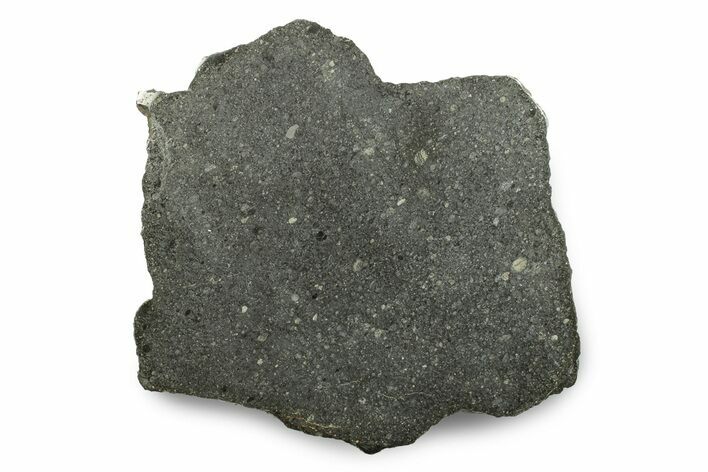3.85" Polished Ghubara Meteorite Slice (152.7 g) - Oman
This is a 3.85" wide (152.7 gram) stony (chondrite) meteorite from a 1954 fall in Ghubrah, Oman. This was the first meteorite ever discovered in Oman. The total weight is not known, but could be as much as 1.75 tons. Portions of Ghubara are studied at the University of Utrecht in the Netherlands.
This is classified as an L5 chondrite, since slicing reveals L5 clasts in an L3 host. Alternatively, it could also be classified as an L3 meteorite with L5 xenoliths. It is a regolith breccia that formed on the surface of its parent body before being ejected by an impact around 500 million years ago.
This piece has been cut flat and polished on one side, revealing the reflective inner metallic inclusions.
This is classified as an L5 chondrite, since slicing reveals L5 clasts in an L3 host. Alternatively, it could also be classified as an L3 meteorite with L5 xenoliths. It is a regolith breccia that formed on the surface of its parent body before being ejected by an impact around 500 million years ago.
This piece has been cut flat and polished on one side, revealing the reflective inner metallic inclusions.
What Is An L5 Chondrite?
An L5 chondrite is a type of stony meteorite that falls under the "L" (low iron) chondrite group. L chondrites have lower iron content (around 7-11% iron, mostly in the form of iron sulfide or silicates) and typically show less metal than H chondrites (high iron chondrites). They primarily consist of silicate minerals like olivine and pyroxene.
The "5" rating indicates a high degree of thermal metamorphism. This means that the L5 chondrite experienced substantial heating, likely on its parent asteroid, which caused partial recrystallization of minerals. As a result, the original chondrules (small, rounded particles) are less distinct and partially altered, though still visible. L5 chondrites usually have a light to medium gray matrix, and the chondrules tend to be less clearly defined due to metamorphic alteration. You may still see rounded chondrule outlines, but they appear partially integrated with the surrounding matrix.
The L chondrite group is believed to come from a specific parent body in the asteroid belt, which likely experienced a major collisional event. This event may have sent large quantities of L chondritic material into space, resulting in the abundance of L chondrites found on Earth.
An L5 chondrite is a type of stony meteorite that falls under the "L" (low iron) chondrite group. L chondrites have lower iron content (around 7-11% iron, mostly in the form of iron sulfide or silicates) and typically show less metal than H chondrites (high iron chondrites). They primarily consist of silicate minerals like olivine and pyroxene.
The "5" rating indicates a high degree of thermal metamorphism. This means that the L5 chondrite experienced substantial heating, likely on its parent asteroid, which caused partial recrystallization of minerals. As a result, the original chondrules (small, rounded particles) are less distinct and partially altered, though still visible. L5 chondrites usually have a light to medium gray matrix, and the chondrules tend to be less clearly defined due to metamorphic alteration. You may still see rounded chondrule outlines, but they appear partially integrated with the surrounding matrix.
The L chondrite group is believed to come from a specific parent body in the asteroid belt, which likely experienced a major collisional event. This event may have sent large quantities of L chondritic material into space, resulting in the abundance of L chondrites found on Earth.
$415
TYPE
Ordinary Chondrite (L5), black, xenolithic
LOCATION
Oman
SIZE
3.85 x 3.75", .25" thick, 152.7 grams
CATEGORY
ITEM
#247049
 Reviews
Reviews










